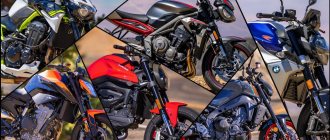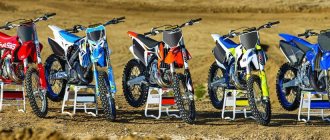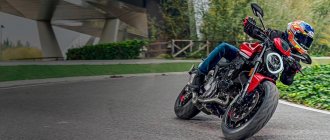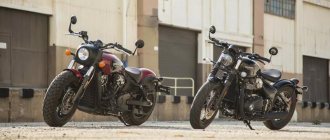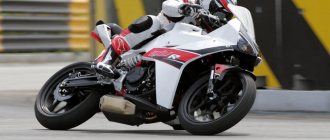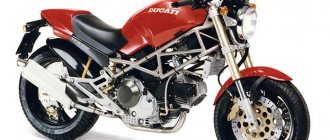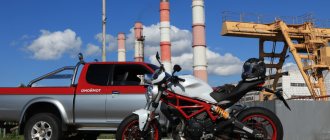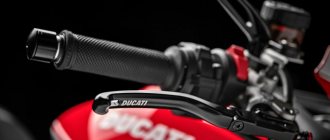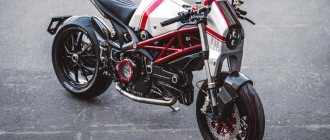Yamaha XSR900
The Yamaha XSR900 is another motorcycle from the “Faster Sons” series that I had the opportunity to ride. This is the next release of a modern motorcycle made to look like a retro model. How to drive it? What are its strengths and weaknesses? More on all this in the next review.
The Yamaha XSR900 is a bit of a throwback for me. This is not because I have already dealt with the engine in the MT-09. This is because I had similar feelings before when I rode the XSR700. I've ridden this bike better than the MT-07 Moto Cage or Tracer 700 . The XSR900 was much better for me than the MT-09. I haven't yet owned the Tracer 900 (which I've heard a lot about) and may not be impressed. However, now I am sure: the XSR series is better for me than the MT.
Of course, the XSR900 has its drawbacks
Lights first. In the era of ubiquitous LEDs and the usual beautiful beam of white light, here at night we face impenetrable darkness and cannot see a thing. There may not be so much that you can't see what the appearance actually is like many years ago. This is a yellow light, timidly peering several meters into the darkness. Of course, this is due to the desire to maintain the look and climate of yesteryear, but LEDs are behind them. There were a total of LEDs in the rear of the Kawasaki 900K, but the lampshade made the whole thing look like a light bulb.
In addition, the passenger seat is uncomfortable. Basically, it's just an add-on. Such as fulfilling a “standard”. I had the opportunity to ride with a small backpack (if you're interested in that episode, you'll find it here ), but the short, hard seat became an issue. In general, my friend was used to riding, holding my back, on the “sport”, and she generally liked her position. However, if even for her sometimes there seemed to be little space, then for someone over 170 cm tall, holding on to the driver’s back can be a little scary.
Yamaha XSR900
The XSR900's mirrors are another issue on this bike that has been found on subsequent Yamaha models, and again I have issues with visibility in them. But in reality it's easy to fix.
Brief history of the model
- 2016 - start of production and sales of the model. First generation
.
Model
: Yamaha XSR900 + ABS (all markets).
Factory designation
: B901, B903, B904, B905, B907, B908, B90B, B90C, B90D, B90E.
- 2017 - appearance of the Abarth modification.
Model
: Yamaha XSR900 + ABS, Yamaha XSR900 Abarth (all markets).
Factory designation
: B90H, B90J, B90K, B90N.
- 2018 - no significant changes.
Model
: Yamaha XSR900 + ABS (all markets).
Factory designation
: B90P, B90R, B90W, B90X, B90Y.
- 2019 - no significant changes.
Model
: Yamaha XSR900 + ABS (all markets).
- 2020 - no significant changes.
Model
: Yamaha XSR900 + ABS (all markets).
- 2021 - no significant changes.
Model
: Yamaha XSR900 + ABS (all markets).
- 2022 - restyling of the model. Second generation
.
Model
: Yamaha XSR900 ABS (all markets).
But let's move on to the driving experience, because...
… there is always something to join. The more different motorcycles you know, the faster you catch these things. But at the same time, you know exactly whether it goes well, worse or maybe better than other bikes. But I remember the Yamaha XSR900 as a good motorcycle. It is definitely better than the series of motorcycles from the same stable. I rode this bike so well that, despite all these shortcomings, I was sad to part with it.
However, I must mention an interesting experience I had with the XSR900. Namely: at some point the pointers stopped working. I started the motorcycle as usual, waiting at the end of the procedure on the clock, but while riding the direction did not start. Only after turning off and restarting the motorcycle did everything return to normal. I've never seen anything like this before. Still, it's a brilliant piece of equipment.
Ducati Monster 1200S
The Ducati Monster 1200S is updated for 2021, getting Ducati quickshifter and tilt ABS among other goodies. Ducati says it's “more compact, slimmer and sportier,” and it even has the cool gas tank clasp like the original M900. Really, why would they change anything if it’s already selling so well? On the other hand, I've always said that the left side of the bike looks like the bottom of a freezer ever since they switched to liquid cooling. Is there really nothing that can be done about this?
Ducati Monster 1200S
Besides its dated looks, what's not to like about a bright red, 132-horsepower, 90-degree V-twin motorcycle? It goes where you point it, loves to wheelie, and is plush thanks to great Ohlins suspension. The Ducati Monster 1200S quickshifter works great, and they seem to have solved the main problem with the previous Monster - its stupid gearbox. True, for some reason they forgot to put cruise control on.
The Ducati Monster 1200S sits at a slightly higher angle than the others, and its footpegs are slightly higher. Overall, it's a bit sportier than the FTRs and XSRs, and if you're big, you'll find it less comfortable than those. According to our overall ratings, the Monster gets fourth place in ergonomics, but first place in engine, brakes and suspension.
Ducati Monster 1200S review #1
The only real sports naked bike of the four, the Ducati Monster 1200S leaves the Indian FTR plodding along on any twisty road. But compared to the Yamaha, it is only better in the way it exits tight corners , using every extra Newton meter from every extra cube, only to be overtaken by the Yamaha XSR on the next braking before the next corner. The Ducati Monster 1200S bends the rider into a very sporty position, especially in the knee area. The Ducati Monster 1200S is beautiful on the right and covered in disgusting hoses on the left.
Ducati Monster 1200S
Ducati Monster 1200S review No. 2
The Ducati Monster 1200S is the purest sportbike among others, and the 11-degree Testastretta engine lets you know that every time you spin it. Yes, it has excellent traction, allowing it to be at its best in every narrow turn, but it especially opens up on a straight road - open the gas - and take off! The rest of it is exactly what you'd expect from a Ducati Monster 1200S - the Ohlins suspension is impressive as always, and the Brembo M50 calipers provide the best braking and feedback of the four. Monster is already quite well known, you know its pros and cons in advance and either accept them or look for another motorcycle. Yes, the exhaust warms the leg and the seat. Components placed outside the engine detract from its beauty. And although the upper body position is quite relaxed, the legs are bent in a decidedly sporting spirit - which is good for conquering corners under the knee, but tiring in city driving.
Ducati Monster 1200S review No. 3
Ducati is always Ducati. He drives like a monster. It handles like a sportbike and stops in an instant. Is anyone surprised by this?
The design team working on the Ducati Monster 1200S had a hard time. They needed to make the Monster recognizable, in the spirit of Miguel Galluzzi's original work, but also technically new. As a result, after all these years, the recognizable Monster silhouette and Ducati's signature red paint still look attractive. And of course, in terms of fast driving, he outpaced the remaining three, but this is already clear. But after driving it around the city, I realized that I would like to drive it only occasionally for one simple reason: the exhaust fried my thighs and butt.
What is a definite plus in the Yamaha XSR900
The most important thing is how this bike rides. It's just a fairy tale! He moves confidently, even too confidently. The motorcycle is so easy to control that after a few rides the driver gets the impression that he is no longer 100% overloaded with equipment. Perhaps this impression was due in part to the fact that I had ridden a Gold Wingu before this bike, but I bet this hardware just rides so well. The same thing happened with the XSR700.
On the shore plus position on a motorcycle. I felt comfortable, straight position. And despite the harder couch and the fact that I slid onto the tank and the heels in my athletic shoes I got to the passenger sets, it still felt comfortable. The route up to 150 km was so easy and pleasant that I could go further.
Yamaha XSR900
The bike also has a great clock. The negative colors on display are actually much better than the standard combination. I mean black dial and whitish display. Even this thin line of rotation becomes more noticeable. I liked the readings in the MT-09 SP, and I was not disappointed here either. I'm leaving out the fact that the oval speedometer space was better used here than in the SCR950 or Husqvarna. However, many left to indicate the temperature. The outside air temperature shows very high, probably due to the proximity of the sensor to the engine. In contrast, the engine temperature gauge stubbornly shows 68 degrees as the maximum value. Yes, it was already cold, but not like that. Well, except that this cooler is so effective.
This is what the Yamaha XSR900 races
I already know the engine. And it works just as well as in the MT-09. The anti-jump grip is excellent. Although in this case, on freshly threaded tires, sometimes with the reduction of higher revs on wet ones, the wheel required a moment of forgetfulness. Unfortunately, we don't have a smooth shifter in the XSR900, but the gearbox works with precision and doesn't cause any problems while driving. I have no comments to work with all my heart. Plus the excellent sound coming from the exhaust of the accessory. The question is, what about this engine temperature?
Cafe racers eat your eyes out. They just look like racing cars. Yes, it’s cool, but no one cares about their capabilities, they dressed up a fashionable tchotchke from 2016 in outfits from the sixties. And I'm very glad that the XSR900 is not one of them after all.
This is the XSR900. The latest thing to come out of the time machine is in the Yamaha sports traditions department. Features of the past. Possibilities of the future. A question begs for him, but the question is not “what?”, the question is “when?”. Cafe-to-café racing began here in sixties Britain with a cup of coffee and the desire to go fast. But today they are no longer so much about speed as they are about images. Now I’ll explain, here’s a quote from Yamaha: The appearance of the XSR 900 is called neo-retro, the motorcycle is made from pure and original materials, for those who value originality and who need an honest and original motorcycle. Whatever this nonsense means, it's definitely not like those performance-focused, all-purpose Japanese bikes of the past. Looks more like a rollback and divorce of millennials. To understand what school he is from, let’s go from a cafe from 1963 to a modern coffee shop. The bike feels solid from the very beginning. The landing is straight, the characteristics are modern, everything is like a real UJM. With a height of one to ninety meters, the saddle height of 830 mm is still nothing, although the knees do not fit into the recesses on the tank. And thanks to ultra-light modern components, the wet weight of the motorcycle is only 195 kilograms. But does the XSR900 achieve the speed desired by the racers of that time? Or is this just another modern pacifier? And this is a great place to find out. The engine and frame in the XSR900 are the same as the famous MT-09 from 2014. The 847 cc inline three delivers so much power and silliness across the entire tachometer range that you almost forget that the MT-09's throttle response was like a kamikaze switch, and the suspension just cried. But on the XSR900, Yamaha have fixed it, they've tightened up the fork damping so there's more bounce on the road and the throttle isn't like a switch anymore. It turns out that they took an already fast motorcycle and made it quickly easier to ride. So perhaps he has earned the title of café racer after all. But during the Cold War, when this runway was built, there was only one way to find out if a motorcycle was worthy of its name. Time to make a ton. 80! 95! 110! 130! 145! Sixth! 160 kilometers per hour! Still gaining! 180! 190! Here, here, 210, that's it. Oooh, I don’t fit in. Brake, brake, brake, brake. When you step back onto the ground you notice something else. The motorcycle is very nimble and does not like to ride on both wheels. Everything is provided, ABS, two-level traction control, 3 driving modes. The standard is suitable for the city, in mode A the handle responds to the power of thought, and B is the “granny” mode, personally, two would be enough for me. It’s worth mentioning the clutch, it seems Yamaha are proud of it, essentially it’s a slipper clutch with a support function, squeezing is 20% easier and when you descend sharply, the rear one doesn’t lock up so much. But, to be honest, in my opinion the engine braking on the XSR900 is already quite weak, so other than making life easier for the left hand, there is not much use from slipping. But another problem is noticeable in the city. Did I mention that due to the stiff suspension it lays down well? So, when you drive along a rough road, you feel every bump and every hole. The seat is wider and more comfortable than the MT-09, but it still rubs in places I'd rather not show. That's how I got to a modern cafe. The smell of coffee makes your nose itch, and the cafe racers eat your eyes. They just look like racing cars. Yes, it’s cool, but no one cares about their capabilities, they dressed up a fashionable tchotchke from 2016 in outfits from the sixties. And I'm very glad that the XSR900 is not one of them after all. Large and thick radiator, sensors and electronics, sports tires and a very low frame. This motorcycle is not some kind of bullshit, it’s a serious piece of equipment. Racing, in the old, true sense of the word. So would I buy one? It is head and shoulders above any of the vintage class. R-Ninety is too expensive, the CB1100 is a dinosaur, Bonnevilles don’t drive like that, Guzzi still go find it, Ducati Sport-Classic is already dead, and the Scrambler is a toy compared to this. But no, I wouldn't buy the XSR900. He just overdid it. If you need a sport without plastic, I will take a sport without plastic. If you want an antique trinket to ride around the city, why should I fry on 150 fire-breathing horses? I like this bike and I wish I needed it, but it's not a 63 outside the window. And for the power of our days, the distances between cafes are simply not enough.
Driving impressions on the Yamaha XSR900
As I mentioned earlier, this bike felt really good to ride. You can't forget the impact of shortcuts. Thanks to this, driving at a speed of 140 is not a problem. Interestingly, in 6th gear at this speed the instantaneous combustion is 5.5L/100km. This is an excellent result for the 900. Combustion in my case was 5.86 l/100 km and I was not driving slowly. In general, the first full filling of the tank took place at 170 km
Yamaha XSR900
The problem may be that the bike is short. This is felt at higher speeds when the head goes to the clock. Unfortunately, this bike requires you to adopt a cat-up position because the windshield is close enough that the stock quickly gets caught in the rider's seat stopper. All this at a height of 180cm. But at least there's no problem reaching the ground with both feet.
The bike also has excellent brakes. Well functioning ABS on the front panel. At the rear, it's mostly a nuisance addition. But the circle was not raging, neither wet nor dry, nor sand. It only gets lost on larger rocks on gravel roads. However, one finger solves braking problems.
Driving characteristics, fuel consumption
The maximum speed announced by the manufacturer was 203 km/h . But users argued that the 240 km/h on the speedometer is quite achievable if there is high wind protection.
Acceleration to hundreds
Acceleration from zero to 100 km/h was 4-4.5 seconds .
Fuel consumption
Fuel consumption according to the designers is 5.75 liters. per 100 km . According to user tests - 6 liters per 100 km at an average cruising speed of 120 km/h .
What else about Yamaha XSR900
I also like the amps on this bike. We have 3 pull levels including an OFF position. 1 degree of control allows for a little more madness. If the wheel slip is not too great, then even the tires are there. However, on sand it is constantly trimmed and gives energy. 2nd degree traction kills the pleasure by 102%, because before you think about anything, the motorcycle will already put the wheels on the asphalt. But on sand you can accelerate smoothly. Traction can only be turned off when the motorcycle is stopped and a little sad. But it works great.
The cards are also 3. STD, where we have strength at the bottom and at the top. Setting A gives us a low kick. On the other hand, B is an STD with less throttle response, which is the position I usually drive in. Convenient off-road and in traffic jams. Everyone will find their place here, because the differences are felt.
Yamaha XSR900
It's just as good on it at higher and lower speeds. Traffic jams are also not a problem. The motorcycle has such a steering wheel width and mirror position that you can safely drive among cars. This can be clearly seen in the video at the bottom of this post.
Comparison participants
On my first ride on the Indian FTR1200, the exhaust pipes suggested comparisons to the Ducati Monster, and the Monster 1200S had just been updated, so that goes without saying. I admit that the Yamaha XSR is a little out of the woods here with its 847cc triple versus the 1200cc twin. But when I saw the XSR in the dealer's garage, I literally said, "wow, is that really an old flat tracker you have here?"
With the XSR, Yamaha was clearly aiming for the same image as Indian. So why not add this model to the comparison? The Yamaha XSR has been on the market for several years, but we haven’t really tested it, much less compared it with others. So it’s decided - let’s take it.
Well, since we already have an unusual comparison of city motorcycles, we decided to take another non-standard step. We took two Indians—a base model and an S—largely because Indian agreed to give them to us. The S model comes with a 4.5” LCD display, tilting ABS, traction control, three ride modes and adjustable suspension.
To sum up the Yamaha XSR900
Great motorcycle! For me it is better than the MT series. Apart from the look that I associate with my youth, it's better to ride it. It was easier for me to do everything that my dull mind suggested,
you can find out more about this on the manufacturer's website. There is also a configurator and a list of add-ons for this model. Below are some of the most important options and a video review that I recommend you watch.
| engine's type | 3-cylinder, 4-stroke, liquid-cooled, DOHC, 4-valve |
| capacity | 847 cm3 |
| Maximum power | 115 hp at 10000 rpm |
| Maximum torque | 87.5 Nm at 8500 rpm |
| total length | 2075 mm |
| Overall Width | 815 mm |
| Overall height | 1 135 mm |
| Saddle height | 830 mm |
| Operating weight | 195 kg |
| Fuel tank capacity | 14 liters |
Post Views: 3,320
Dimensions and weight
Already at the first acquaintance with the Yamaha XJ 900 S Diversion, you get the feeling that there is a heavy war horse in front of your eyes. And when you roll the motorcycle out of the garage, you feel the mass with all your muscles.
The steel frame could not but affect the weight of the motorcycle:
- dry weight was 240 kg ;
- equipped, with oil filling and a full tank of gasoline - 265 kg .
The dimensions were also not surprising:
- length - 2,231 mm ;
- width - 736 mm ;
- in height - 1,302 mm ;
- seat height - 796 mm ;
- wheelbase - 1,506 mm .

